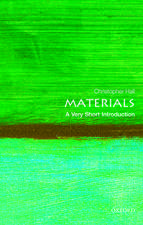Adhesion and Friction in Biological Systems: Biologically-Inspired Systems, cartea 3
Editat de Stanislav Gorben Limba Engleză Hardback – 14 oct 2011
| Toate formatele și edițiile | Preț | Express |
|---|---|---|
| Paperback (1) | 944.51 lei 6-8 săpt. | |
| SPRINGER NETHERLANDS – 23 aug 2016 | 944.51 lei 6-8 săpt. | |
| Hardback (1) | 948.92 lei 6-8 săpt. | |
| SPRINGER NETHERLANDS – 14 oct 2011 | 948.92 lei 6-8 săpt. |
Preț: 948.92 lei
Preț vechi: 1157.22 lei
-18% Nou
Puncte Express: 1423
Preț estimativ în valută:
181.63€ • 197.36$ • 152.67£
181.63€ • 197.36$ • 152.67£
Carte tipărită la comandă
Livrare economică 21 aprilie-05 mai
Preluare comenzi: 021 569.72.76
Specificații
ISBN-13: 9789400714441
ISBN-10: 9400714440
Pagini: 350
Ilustrații: XIII, 280 p.
Dimensiuni: 155 x 235 x 20 mm
Greutate: 0.54 kg
Ediția:2012
Editura: SPRINGER NETHERLANDS
Colecția Springer
Seria Biologically-Inspired Systems
Locul publicării:Dordrecht, Netherlands
ISBN-10: 9400714440
Pagini: 350
Ilustrații: XIII, 280 p.
Dimensiuni: 155 x 235 x 20 mm
Greutate: 0.54 kg
Ediția:2012
Editura: SPRINGER NETHERLANDS
Colecția Springer
Seria Biologically-Inspired Systems
Locul publicării:Dordrecht, Netherlands
Public țintă
ResearchCuprins
Adhesion and Friction in Biological Systems.- Introduction.- I. Adhesion.- Chapter 1. Pollen grains adhere to the moist mouthparts in the flower visiting beetles.- Chapter 2. Material structure, stiffness, and adhesion: why attachment pads of the grasshopper (Tettigonia viridissima) adhere more strongly than those of the locust (Locusta migratoria) (Insecta: Orthoptera).- Chapter 3. Attachment force of the beetle Cryptolaemus montrouzieri (Coleoptera, Coccinellidae) on leaflet surfaces of mutants of the pea Pisum sativum (Fabaceae) with regular and reduced wax coverage.- Chapter 4. Visualization of epicuticular grease on the covering wings on the Colorado Potato Beetle: A scanning probe approach.- Chapter 5. Fracture behaviour of plant epicuticular wax crystals and its role in preventing insect attachment: a theoretical approach.- II. Friction.- Chapter 6. Microtribology of biological materials.- Chapter 7. Friction and adhesion in the tarsal and metatarsal scopulae of spiders.- Chapter 8. Frictional properties of contacting surfaces in the hemelytra-hindwing locking mechanism in the bug Coreus marginatus (Heteroptera, Coreidae).- Chapter 9. Surface structure and frictional properties of the skin of the Amazon tree boa Corallus hortulanus (Squamata, Boidae).- Chapter 10. Material properties of the skin of the Kenyan sand boa Gongylophis colubrinus (Squamata, Boidae).- III. Attachment Devices.- Chapter 11. Evolution of locomotory attachment pads of hexapods.- Chapter 12. Ultrastructural architecture and mechanical properties of attachment pads in Tettigonia viridissima (Orthoptera Tettigoniidae).- Chapter 13. Contact behaviour of tenent setae in attachment pads of the blowfly Calliphora vicina (Diptera, Calliphoridae).- Chapter 14. The probable purpose of the mid-coxal prong in Brachycera (Diptera).- IV. Attachment-related behaviour.- Chapter 15. Contact mechanics at the insect-plant interface: How do insects stick and how do plants prevent this?.-Chapter 16. Insect walking techniques on thin stems.- Chapter 17.- Plant surface-bug interactions: Dicyphus errans stalking along trichomes.- Chapter 18. Locomotion in a sticky terrain.- Index.- Literature.
Textul de pe ultima copertă
This book is a collection of experimental studies demonstrating structure-function relationships in various biological systems having particular surface specialization to increase/decrease friction and adhesion. Studies on snake skin, adhesive pads, wing-interlocking devices and sticky mouthparts of insects as well as anti-adhesive and adhesive surfaces of plants are included in the volume containing four main subsections: (1) adhesion, (2) friction, (3) attachment-devices, (4) attachment-related behavior. Numerous experimental methods for characterizing tribological properties of biological surfaces at macro-, micro-, and nanoscale levels are demonstrated. This book is an example of interdisciplinary science in action, combining approaches from biology, physics, engineering, tribology, and materials science. This work is an excellent collection of papers on biotribology for both engineers and physicists working with biological systems as well as for biologists studying friction and adhesion. Since biological surfaces have a great potential for technological ideas that can be used in developing new materials and systems, inspirations from biology reported here may be also potentially interesting for biomimetics.
Caracteristici
Broad range of biological surfaces is considered Some papers from the book meanwhile belong to classical ones in the field Detailed description of microscopy methods and tribological characterisation techniques helps readers in designing own studies on the topic






















